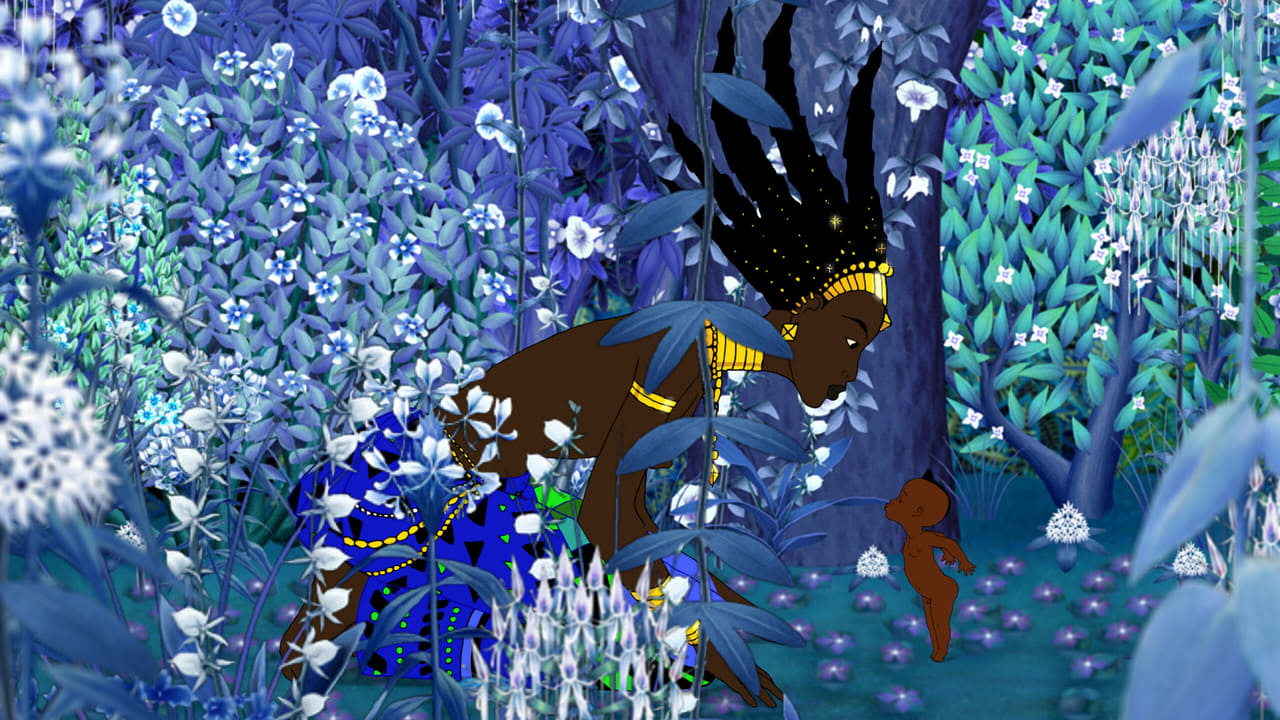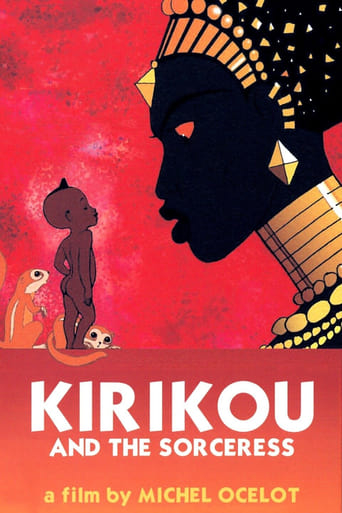

Very well executed
... View MoreThis is one of the few movies I've ever seen where the whole audience broke into spontaneous, loud applause a third of the way in.
... View MoreExcellent characters with emotional depth. My wife, daughter and granddaughter all enjoyed it...and me, too! Very good movie! You won't be disappointed.
... View MoreThe film's masterful storytelling did its job. The message was clear. No need to overdo.
... View MoreKirikou is a different film than we are used to. Even though it is a cartoon, it is not a cartoon for children. The only reason this film cannot be considered a child relatable film is because all of the women are topless. Other than that, the story line is quite child friendly. This film tells the story of a baby named Kirikou, and his journey in defeating the evil sorceress, Karaba. Kirikou is courageous in many ways: he is brave, he loves his mother, he takes care of the village, and he is optimistic. We see many of these qualities in our European films, however, nine times out of ten, in European films, the mother is either dead or never around. Kirikou seeks help from his mother to defeat Karaba.Karaba is portrayed as evil throughout most of the film. At the beginning she is viewed evil because she is a sorceress and has done many evil things but towards the end you find out she is not evil at all, she is in pain. Kirikou finds the source of her pain and relieves her from it, since her pain is gone so is her power, a small sacrifice for the elimination of monumental pain. She did however, turn all the men into evil machines and take the village's gold, and the villagers cannot forgive her for these evil actions. After Kirikou explains she did not do any of these evil tasks, his mother supports then his grandfather comes to speak his words of wisdom and tells us the moral of the story: we must forgive.This story is like a reverse princess and the frog. The frog must learn a moral lesson that beauty lies within, whereas in this story Karaba learns a man is a man based on his actions not his size. Kirikou solves many problems to bring peace back to his village, but his family solves the final problem in showing Karaba is not evil. Thus showing it is possible to forgive even though they had suffered so greatly.I personally really liked this film. I thought it was very entertaining and not difficult to understand. Having the option to watch it without subtitles also made it easier to understand. Even though the film was a cartoon and had very many childlike qualities, I still would only recommend this film to a mature audience. As previously stated it is mildly graphic since it shows half naked women.
... View MoreI really liked watching Kirikou and the Sorceress because the story was a classic struggle against evil. The hero is about as unlikely as they come (how many newborn babies match wits with sorceresses?) he's brave, and kind, and smart, and sometimes he feels "a little small and frightened." What I love best about Kirikou as a hero is that he is a child. Kirikou tells his grandfather that he would like to be grownup so that he can defeat the sorceress, but his grandfather tells him that "none of the grown-ups succeeded." The story of Kirikou and the Sorceress was beautifully told. I didn't notice the soundtrack very much, but when I did notice the music it was quiet and pleasant to listen to. Even though the songs with words are earworms that got stuck in my head, those were also pleasant to listen to. The animation makes me think of watercolor paintings. The pictures on the screen are fairly sparse, the village scenes don't have a lot of added details, the plants are stylized, and the people are mostly outlined blocks of color, but this is perhaps the strength of the animation. I think this reflects the simplicity of the story, it isn't supposed to be a really complicated story, just what matters.I would recommend this movie to people who are invested in the concept of story and suggest that they consider the differences in classic American story (descended from European story) and classic African story.
... View MoreIn this film, "Kirikou and the Sorceress", the director is not only focusing on the revival and retelling of a famous African hero by the name of Sundiata, but he, like most African storytellers, announces to his audience the true nature and theme of the film. So what is the meaning to the film? The director believes that with modernity comes sacrifices and loss of tradition, which in turn leads to not only detrimental change but culturally damaging affects. Whether through subtilties of music and color or boldness of characterization and storyline, the director uses the story of Kirikou as a background for the viewer to be entertained and captivated while simultaneously able to relate and understand the struggles of such once seemingly inevitable metamorphoses.The movie begins with a small child crawling from his mother's womb asserting his independence while containing the wisdom far superior to that of the village elder and the courage of more than ten warriors. This boy is Kirikou, he is the living embodiment of all that is African bravery and intelligence. Kirikou is a relatable and lovable little boy, he is the force against evil but his small stature condemns him to the underdog role. Every American roots for the underdog, but in Kirikou's case, he is a confident, courageous and fast hero; he is the life of African hope against evil. Kirikou is tradition, he is the purity and innocence of African tradition, therefore, the director uses this main heroic figure as the personification of tradition itself, which rises to any challenge and ultimately prevails against evil.In contrast, the director's motivation for creating the sorceress, Karaba, as a man-eating, "mean and evil" presence is because she is the representation of the evil of modernity. She possesses evil fetishes, which are her lookouts and minions, but each of these evil followers is mechanically operated and functions only as a robot. These mechanized beings are portrayed as evil, therefore there is no doubt that the director believes that modernity is corrupt and in a sense, evil. Karaba herself is also the personification of evil in modern society and machinery because she is a soul-less entity who possesses not even one friend. Just her presence turns trees, shrubs and flowers into dead and dying weeds. With such bold interpretations and opinions, the director's characterization clearly states his view of modernity and how its presence kills all of Africa's cultural traditions as surely as Karaba kills all living plants and beings.Although the director does use obvious portrayals of evil modernity and the goodness of tradition, he also hints at the main theme through subtle musical inflections. While the camera pans in on Kirikou's village the music is soft, almost unnoticeable, calming and soothing. The beats are as beautiful as the pink leaved trees and as elating as the infectious hugging chipmunks in the garden beyond the sorceress' hut. The melodies are uplifting and simply happy while the kids are swimming in the lake and the women and children sing in unison while praising Kirikou. But just beyond the village there is a different sound to be heard. The music turns solemn and black as the sky blends to grays and dark hues. All melodies are lost and ominous feelings overcome the body as the scene focuses on Karaba's perimeter of darkness. With musical changes from happiness to fright, the theme of evil and purity can be witnessed and all the viewer has to do is have a watchful ear.The colors are also an indicator of modernity's evil ways and tradition's healing power. As mentioned briefly before, the colors change as often as the music, therefore indicating the transformation from the dark, gloomy and controlled reign of Karaba to the warm, rich colors of freedom as expressed in the village landscapes and natural forests. Colors seem to be just a significant in the interpretation of the story of Kirikou as the characterization that the director relies on as the literal and easier form of indicators of good and evil.The director does not stop there, however. Although, the director believes that evil describes modernity and that traditions is inherently good, there is another piece to the main theme puzzle. The main question of the movie revolves around why Karaba is so mean and evil, and as the ending reveals, Karaba is mean and evil because she has a thorn embedded in her spine supplying her with evilness and wrong doing. But as Kirikou bites the deeply embedded thorn with his teeth, and removes the painful object, Karaba is cured of her evil and is ultimately saved. By adding the salvation ending, the director believes that there is hope for tradition to thrive and that modernity is not an inevitable evil, but an evil that is deeply good but on the surface, contains an evil face.The story of Kirikou and the evil sorceress is a tale of overcoming adversity and extending hope to those who seem to be as drained of hope as the spring of water, but the story is also more personal than that. With evidence such as characterization, musical and color differences as well as ending plot, the main theme of Kirikou is to hail the significance of tradition and to preserve culture while undergoing moderate changes without dramatic and modern assimilation.
... View MoreI felt that the animated film Kirikou and the Sorceress, directed by Michel Ocelot, and was an enjoyable film. Ocelot does a great job portraying African culture in a fun and traditional manner.This culturally rich African folklore presents a classical hero story which was great because of the unique manner in which it was presented. Although the film was your typical hero story, it was the introduction of an unlikely hero that first got me. Little baby Kirikou, fresh out of the womb; lighting quick and very wise is what first took me out of my comfort zone. In addition to our hero being a naked infant, all the characters run around topless which wasn't bad thing, just different. The movie was very simple and yet very complex at the same time. Simplistically speaking it was the actual story line, the graphics, the communication between characters it all very direct meaning if there was a problem the character would state the problem and then how he should fix it, which made the story easy to follow. The colors in this film made it clear how you were suppose to feel. With technology and the evil sorceress being represented in dark colors and culture, tradition seen as the village represented in light colors and fun music. I felt the complexity lied in the overall message the movie was trying to convey and by many people this message could be interpreted in different ways.Overall I enjoyed the movie because it conveyed a serious message in a fun and entertaining manner. As I stated before, the movie was culturally different for me but this unique experience also kept the movie exciting. I would recommend this film to anyone who likes anime-folklore films or almost any Disney fan of any type because I felt this film had a strong "Disney" element to it. Disney element, basically meaning the film was friendly and the manner in which they told their story was cute and fun.
... View More